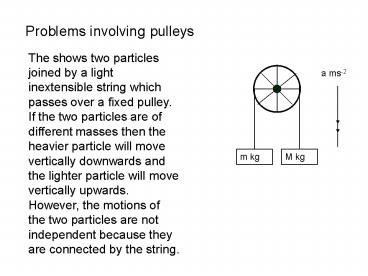Problems involving pulleys - PowerPoint PPT Presentation
1 / 10
Title:
Problems involving pulleys
Description:
... pulleys ... (b) the tension in the string and (c) the force exerted on the pulley. ... The string pass over smooth pulleys at either end of a smooth ... – PowerPoint PPT presentation
Number of Views:73
Avg rating:3.0/5.0
Title: Problems involving pulleys
1
Problems involving pulleys
The shows two particles joined by a light
inextensible string which passes over a fixed
pulley. If the two particles are of different
masses then the heavier particle will move
vertically downwards and the lighter particle
will move vertically upwards. However, the
motions of the two particles are not independent
because they are connected by the string.
2
Example 1
Particles of masses 5 kg and 3 kg are attached to
the ends of a light inextensible string which
passes over a smooth fixed pulley. The system is
released from rest. Find the acceleration of the
system and the tension in the string and also
find distance moved by the 5 kg mass in the first
2 seconds of the motion. (Assume that neither
particle reaches the pulley or the ground.)
Solution
T 3g 3a
(1)
5g T 5a
(2)
(1) (2) gives
2g 8a
So a 2.45 ms-2
Sub the value of a into (1)
Gives T 36.75 N
u 0
t 2
a 2.45
s ?
s ut ½ at2
s 0 x 2 0.5 x 2.45 x 22
So s 4.9 m
3
Example 2
Two particles P and Q of masses 6 kg and 4 kg
respectively are connected by a light
inextensible string. Particle P rests on a smooth
horizontal table. The string passes over a smooth
pulley fixed at the edge of the table and Q hangs
vertically. There is a friction of 15 N opposing
the motion of the particle. The system is
released from rest. Find (a) the acceleration
(b) the tension in the string and (c) the force
exerted on the pulley.
4
Solution
For the 4 kg mass
4g T 4a
1
For the 6 kg mass
T 15 6a
2
1 2 gives
a 2.42 ms-2
From 2
T 29.52 N
Force exerted on the pulley
Resultant force ?(29.522 29.522) 41.7 N
Acting at 45º to the horizontal
5
Example 3
A block of mass 4 kg is attached by light,
inextensible strings to particles of mass 5 kg
and 10 kg. The string pass over smooth pulleys at
either end of a smooth horizontal able, as shown.
Find the acceleration of the system and the
tensions in the two strings.
6
Solution
For the 10 kg mass
10g T1 10a
1
For the 4 kg mass
T1 T2 4a
2
For the 4 kg mass
T2 5g 5a
3
1 2 gives
10g - T2 14a
4
3 4 gives
5g 19a
Gives a 2.58 ms-2
1 Gives T1 72.2 N
3 Gives T2 61.9 N
7
Example 2
Two particles P and Q of masses 8 kg and 4 kg
respectively are connected by a light
inextensible string. Particle P rests on a rough
horizontal table. The string passes over a smooth
pulley fixed at the edge of the table and Q hangs
vertically. The coefficient of friction between P
and the table is 0.3. The system is released from
rest. Find (a) the acceleration (b) the tension
in the string and (c) the force exerted on the
pulley.
8
Solution
(a)
Resolve (P ? )
R 8g 0
R 8g
F ?R 0.3 x 8g 2.4g
Resolve (P ?)
T F 8a
T 2.4g 8a
(1)
Resolve (Q ? )
4g - T 4a
(2)
(1) (2)
1.6g 12a
gives a 1.31 ms-2
(b)
T 2.4g 8a
gives T 34 N
9
Solution
(c)
Resultant ?(342 342)
48.1 N
at 450 below horizontal
10
Example 3
A body of mass 5 kg is placed on a smooth plane
inclined at 300 to the horizontal. It is
connected by a light inextensible string, which
passes over a smooth pulley at the top of the
plane, to a mass of 3 kg hanging freely. Find the
common acceleration and the tension in the string
T 5gsin300 5a
T 2.5g 5a
(1)
3g - T 3a
(2)
(1) (2)
0.5g 8a
so a 0.6125
T 2.5g 5a
So T 27.6 N































